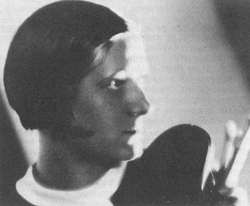DÖMÖTÖR, Gizella
(1894, Budapest - 1984, Buenos Aires)


The posthumous estate of the Mund-Dömötör couple drifted ever farther away from Hungary in the current of history has only become reintegrated into Hungarian art history recently. It is rare that married couples can work without rivalry, mutually enriching each other's work without losing their own individuality. Hugó Mund did not suppress his wife's avant-garde endeavours, and as the press coverage of their many joint exhibitions reveal, they exhibited on an equal footing. In today's evaluation of the history of art, Gizella Dömötör's oeuvre comes through as the product of a very talented, avant-garde spirit, which can be seen in the consistency of her cubo-expressive, formal idiom, built on simultaneous contrasts, as opposed to her husband's more conventional, qualitatively uneven output.
As students of the Budapest Academy of Fine Arts spending their summers in Nagybánya, Gizella Dömötör and Hugó Mund made friends in the artists colony in 1914. In the 1910s, at the advent of women's emancipation, Gizella Dömötör, the offspring of a merchant family in Pest, assumed her devoted commitment to painting with unusual audacity. Both artists painted several times he typical Nagybánya motifs. While in Dömötör's works the handing of colour and light strikes the eye, in Mund's paintings a greater plasticity can be observed. Gizella unfolded her experimenting efforts in Pest from 1915. In 1916 her Still-life and Nude drawings displayed at the National Salon attracted the attention of the leader of the Hungarian avant-garde, Lajos K. That was how two of her works came to be reproduced in the major avant-garde periodical MA in 1917.
The influence of Cézanne and the French modernists can be detected in the work of both painters, especially in variations on the Nudes in the Landscape theme in the 1910s and later. The late 19th century symbolic, Arcadian conception was elaborated further after the example of Hungarian "Seekers" in the work of Dömötör and Mund. In the 1920s the early cubist pieces gave way to a more mystical and expressive approach in Dömötör's oeuvre.
In 1920, they left Budapest to settle in Transylvania. In 1920-24 they enjoyed the patronage of the bishop of Nagyvárad, working only summers in Nagybánya, where they stayed continuously from 1924 to 1930. They didn't align themselves with a single current. Instead of impressions of nature, they were searching for inner essence in their own peculiar way, not independently of the growing influence of Far Eastern philosophies. That was how cubism and expressionism became fused in their pictures in a belated symbiosis typical of East European art. Dömötör's art however is less abstract and pantheistic.
With the gradual worsening of the economic and political situation, the Munds decided to emigrate. They settled in Argentina in 1931. The influence of the avant-garde tendencies had just reached South-America by this time. Mund and D didn't affiliate with any Argentinean art group, except for Gizella's participation in the exhibitions of the association of British painters. Faithful to her earlier style, she gradually incorporated some local motives into her work. Argentinean peculiarities were quicker to find their way into Mund's pictures, be they the decimated Indian natives, the shepherds of the pampas or the labourers of the suddenly swollen metropolis.
In the last period of their lives, they withdrew even more into themselves, producing their increasingly abstract works, mostly for themselves. Their last works were inspired by music. Hugó died in the autumn of 1961. Gizella stopped painting in 1974. She died in 1984, in Buenos Aires.
